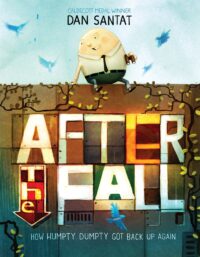SEL Read Aloud: After the Fall: How Humpty Dumpty Got Back Up Again by Dan Santat

Summary
In “After the Fall by Dan Santat, Humpty Dumpty goes into greater detail about the emotional toll his accident had on him long after the king’s men were able to physically restore him. He wasn’t the same at his fall. He was too scared to return to the wall where he once watched birds, and he couldn’t even do simple things, like go grocery shopping, without getting triggered by his fear of heights.
In order to feel closer to his old life, he works hard to build a paper airplane resembling the birds he was now forced to watch from the ground. He flies it through the air and experiences some of the thrills he used to have, but inevitably another accident happens. This time, his plane flies over the wall.
Humpty Dumpty must decide whether to climb the ladder and risk falling again or continue prioritizing his fear over his happiness. As he begins to climb the ladder, readers notice his shell starting to crack, revealing something underneath. At the top, he sees everything again, and his shell falls away entirely. He is a bird who can fly the skies himself, totally free from his fear of falling.
Comprehension Questions
Six questions aligned to Bloom’s taxonomy for teacher’s to evaluate students’ comprehension
- Remembering: What hobby did Humpty Dumpty take up after his fall?
- Understanding: How did Humpty Dumpty’s fall affect his daily activities?
- Applying: Describe a situation where Humpty Dumpty had to make a tough decision after his accident.
- Analyzing: Analyze the significance of the ladder and wall in Humpty Dumpty’s recovery process.
- Evaluating: Reflect on the story’s message about overcoming fears. Do you think the story provides a realistic portrayal of facing and overcoming personal challenges?
- Creating: Design a new hobby for Humpty Dumpty that could help him overcome his fear without risking another fall.
CASEL Discussion Questions
Five questions aligned to the CASEL competencies for teachers to foster an engaging discussion and foster social-emotional learning
- Self-Awareness: How do you think Humpty Dumpty felt after his fall, and how did his feelings change throughout the story? Discuss how our emotions can affect our actions and decisions.
- Self-Management: Discuss the importance of setting goals, like Humpty Dumpty’s goal to fly again, in managing our behavior and emotions. How can goals help us stay focused and motivated?
- Social Awareness: Humpty Dumpty’s story can inspire empathy and understanding in others. How can sharing personal challenges and achievements with friends or family help build stronger, more empathetic relationships?
- Relationship Skills: Consider Humpty Dumpty’s fear of heights. How can we respectfully encourage someone to face their fears without pushing them too hard?
- Responsible Decision Making: Discuss a time when you had to make a difficult decision that involved weighing fears against rewards. How did you ensure you made a responsible choice?
Design Thinking Challenge
Take students’ learning even further by incorporating the Imagineerz design thinking framework
Create a Fear-Conquering Machine
Understand
- Begin with a group reading of “After the Fall” by Dan Santat, focusing on Humpty Dumpty’s journey of overcoming his fear of heights after his great fall. Initiate a discussion about fear and resilience: What fears does Humpty experience, and how does he confront them? Encourage students to share personal stories of fears they’ve faced or are facing, emphasizing the emotions involved and the steps taken to overcome those fears.
Ideate
- Prompt students to brainstorm designs for a “Fear-Conquering Machine” that could help someone like Humpty Dumpty overcome a fear. Encourage creative thinking: What features would such a machine have? How could it help build confidence and resilience? Students should think about elements that provide comfort, encouragement, and gradual challenges to help overcome fears, taking inspiration from Humpty Dumpty’s own strategies for facing his fear of heights.
Prototype
- Students will use classroom materials—such as cardboard, paper, fabric, and recyclables—to create their “Fear-Conquering Machine.” Each prototype should aim to embody a process or activity that encourages facing and overcoming fears, much like Humpty’s approach to climbing the wall again. Encourage students to think about how their machine uses gradual steps, positive reinforcement, or other methods to help users conquer their fears.
Test
- Students will present their prototypes to the class, describing their design inspiration from “After the Fall,” how their machine is intended to work, and how it specifically aims to help someone overcome fear. They could demonstrate its use through role-play or by explaining the intended interaction with the user.
- Collect feedback from peers and teachers on aspects such as the machine’s empathy towards the user’s feelings, its potential effectiveness in helping overcome fears, and suggestions for improvement. Discuss how this project might relate to real-life strategies for confronting and overcoming personal fears, drawing parallels to Humpty Dumpty’s story of resilience and recovery.
Read Aloud
If you appreciated getting to read this book with your class, you might also want to share this book with them!
Additional Resources
Copyright Notice
The image on this page comes from the book After the Fall: How Humpty Dumpty Got Back Up Again by Dan Santat. Copyright © 2017 by Dan Santat.


